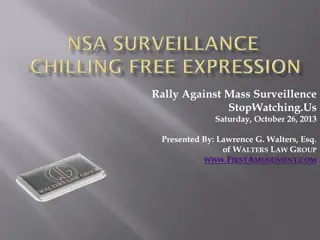Standardized Desk Surveillance Reviews Template
This template provides standardization for desk surveillance reviews to facilitate comparisons across regions and streamline the analysis process. It guides data managers and review team members in conducting desk reviews tailored to specific needs and contexts. Interpretations rely on data accuracy and completeness.
Download Presentation

Please find below an Image/Link to download the presentation.
The content on the website is provided AS IS for your information and personal use only. It may not be sold, licensed, or shared on other websites without obtaining consent from the author.If you encounter any issues during the download, it is possible that the publisher has removed the file from their server.
You are allowed to download the files provided on this website for personal or commercial use, subject to the condition that they are used lawfully. All files are the property of their respective owners.
The content on the website is provided AS IS for your information and personal use only. It may not be sold, licensed, or shared on other websites without obtaining consent from the author.
E N D
Presentation Transcript
Inorganic Chemistry Practical II The First Course By Lecturer Sinan Midhat Al-Bayati Asst. Prof. Anaam Majeed Rasheed Asst. Lecturer Al-Ameen Bariz Omar Supervised by: Dr. Rehab AbdulMahdi Al-Hassan
Experiment No. (7) Preparation of Barium Chloride Di-Hydrate BaCl2.2H2O Preparation of Barium Chloride Di-Hydrate BaCl2.2H2O Barium chloride is an inorganic compoundwhose formulais BaCl2. It is one of the most common water-soluble salts of barium. Like other barium salts, it is toxic and imparts a yellow-green coloration to a flame. It is also hygroscopic. Preparation: Barium chloride can be prepared from barium hydroxide or barium carbonate, with barium carbonate being found naturally as the mineral witherite. These basic salts react with hydrochloric acid to give hydrated barium chloride. On the industrial scale, it is prepared via two-step process from barite (barium sulfate): BaSO4(s)+ 4 C(s) BaS(s)+ 4 CO(g) The first step requires high temperatures. BaS + CaCl2 BaCl2+ CaS The second step requires fusion of the reactants. BaCl2can then be leached out from the mixture with water. From water solutions of barium chloride, the dihydrate can be crystallized as white crystals: BaCl2 2H2O.
Uses: As an inexpensive, soluble salt of barium, barium chloride finds wide application in the laboratory. It is commonly used as a test for sulfate ion. In industry, barium chloride is mainly used in the purification of brine solution in caustic chlorine plants and also in the manufacture of heat treatment salts, case hardening of steel, in the manufacture of pigments, and in the manufacture of other barium salts. BaCl2 is also used in fireworks to give a bright green color. However, its toxicity limits its applicability. The Required Reagents: 1.5 ml of diluted HCl. 2.2 ml of conc. HCl. 3.BaCO3 (1 g). 1.Ice bath.
Procedure: 1)Dissolve (1 g) of BaCO3 in 5 ml of diluted HCl with stirring. 2)Add (2 ml) of conc. HCl. 3)Boil the mixture. 4)Cool down the flask after filtering it in ice bath. 5)Collect the crystals by filtering then dry it at room temperature. 6)Weight the precipitate. Questions: 1.Write the equation of this reaction. 2.Why conc., and diluted HCl are used in this experiment? 3.Calculate the percentage of the yield. Calculate the number of water molecules per formula.























